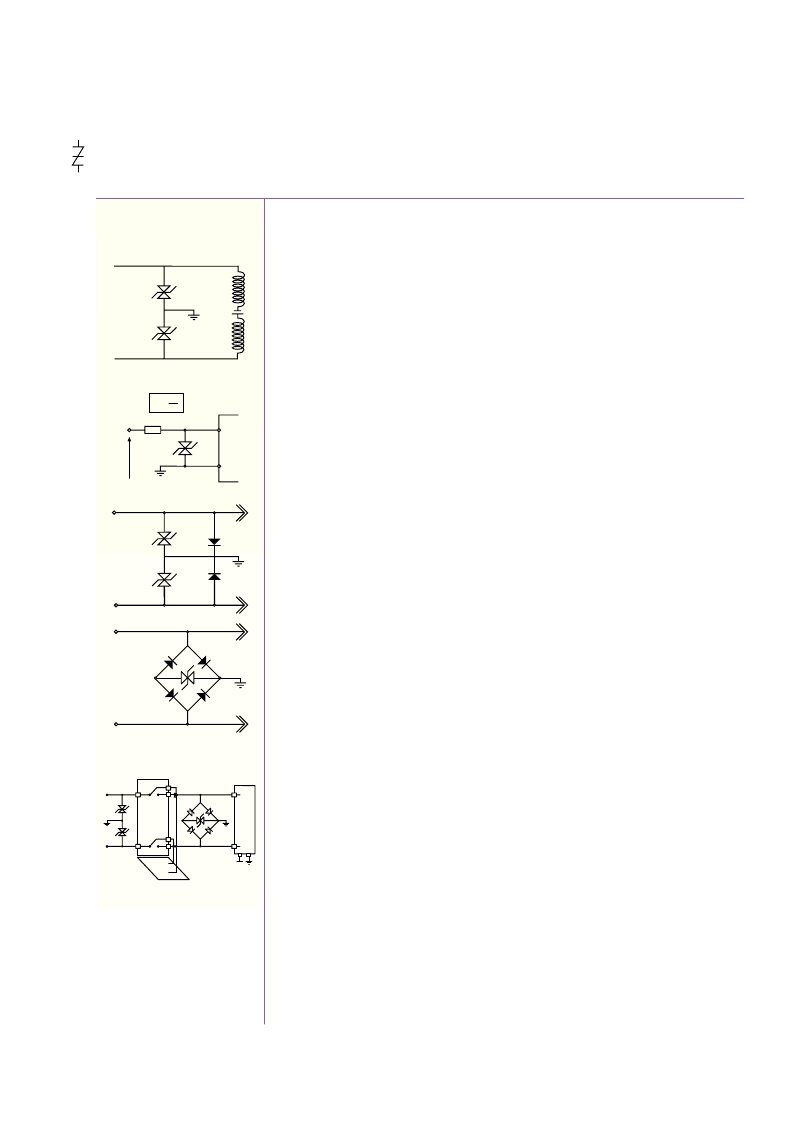- 您現(xiàn)在的位置:買賣IC網(wǎng) > PDF目錄373774 > ZCR3203AC (Electronic Theatre Controls, Inc.) Thyristors (SiBOD Breakover Devices) PDF資料下載
參數(shù)資料
| 型號(hào): | ZCR3203AC |
| 廠商: | Electronic Theatre Controls, Inc. |
| 英文描述: | Thyristors (SiBOD Breakover Devices) |
| 中文描述: | 晶閘管(SiBOD擊穿設(shè)備) |
| 文件頁(yè)數(shù): | 3/9頁(yè) |
| 文件大小: | 277K |
| 代理商: | ZCR3203AC |

DC SUPPLY
R
Equipment
to be
VC
IH >
VC
R
SLIC PROTECTION
CR0640SB
CR0640SB
To SLIC
Line
Line
(-)
CR0640SB
To SLIC
Line
Line
(-)
(+)
(-)
or
COMPLETE PC BOARD
(-)
CR0640
SB
(-)
(-)
(+)
IntSLIC
-V Battery
Line
Line
pon-hook
protection
off-hook
CR2300
Ring
On-hook
Off-hook
On-hook
Off-hook
Ring
orDetection
Circuit
PABX PROTECTION
CR1300SB
CR1300SB
2
To Order: 1-877-502-5500 Fax: 1-858-715-7280
Thyristors (S iBOD
Breakover Devic es)
S i B OD S eri es
A ppl i c ati on Notes
The Added CrydomBenefit
CrydomThyristors (
SiBOD
Breakover
Devices) offer the highest quality and
performance. They also come with an
added benefit – service and technical
assistance to help ensure optimumpro-
tection for your telecommunications
application.
SiBOD Series
The CrydomSiBOD is a four-layer thyristor-
based protector designed specifically for
telecommunications applications. It has
greater capacity for diverting surge cur-
rents than an avalanche TVS device.
The Crydomseries protector is based on
the proven technology of the SiBOD prod-
uct. Designed for transient voltage protec-
tion of telecommunications equipment, it
provides higher power handling than a
conventional avalanche diode (TVS), and
when compared to a GDT offers lower volt-
age clamping levels and infinite surge life.
Electrical Characteristics
The electrical characteristics of the
SiBOD devices are similar to those of a
self-gated Triac, but the SiBOD are two-
terminal devices with no gate. The gate
function is achieved by an internalcurrent
controlled mechanism.
Like the TVS diodes, the SiBOD have a
stand-off voltage (V
RM
) that shouldbe equal
to or greater than the operating voltage of
the systemto be protected. At this voltage
(V
RM
) the current consumption of the SiBOD
are negligible and will not effect the pro-
tected system
When a transient occurs, the voltage across
the SiBOD will increase until the breakdown
voltage (V
BR
) is reached. At this point the
device will operate in a simlar way to a
TVS device and is in an avalanche mode.
The voltage of the transient will now be
limited and will only increase by a few
volts as the device diverts more current.
As this transient current rises, a level of
current through the device is reached
(I
BO
), causing the device to switch to a
fully conductive state such that the volt-
age across the device is now only a few
volts (V
T
). The voltage at which the device
switches from the avalanche mode to the
fully conductive state (V
T
) is known as the
breakover voltage (V
BO
). When the device
is in the V
T
state, high currents can be
diverted without damage to the SiBOD
due to the low voltage across the device,
since the limiting factor in such devices is
dissipated power (V X I).
Resetting of the device to the nonconduct-
ing state is controlled by the current flowing
through the device. When the current falls
below a certain value, known as the holding
current (I
H
), the device resets automatically.
As with the avalanche TVS device, if the
SiBOD device is subjected to a surge
current that is beyond its maximum rating,
the device will fail in short-circuit mode,
which ensures that the equipment is
ultimately protected.
相關(guān)PDF資料 |
PDF描述 |
|---|---|
| ZCR3403AA | Thyristors (SiBOD Breakover Devices) |
| ZCR3403AB | Thyristors (SiBOD Breakover Devices) |
| ZCR3403AC | Thyristors (SiBOD Breakover Devices) |
| ZCYS | Common Mode Filters(SMD) For xDSL |
| ZCYS8684 | Common Mode Filters(SMD) For xDSL |
相關(guān)代理商/技術(shù)參數(shù) |
參數(shù)描述 |
|---|---|
| ZCR3403AA | 制造商:未知廠家 制造商全稱:未知廠家 功能描述:Thyristors (SiBOD Breakover Devices) |
| ZCR3403AB | 制造商:未知廠家 制造商全稱:未知廠家 功能描述:Thyristors (SiBOD Breakover Devices) |
| ZCR3403AC | 制造商:未知廠家 制造商全稱:未知廠家 功能描述:Thyristors (SiBOD Breakover Devices) |
| ZCRMZN00100KITG | 功能描述:仿真器/模擬器 Crimzon IR Dev Dev Board Kit RoHS:否 制造商:Blackhawk 產(chǎn)品:System Trace Emulators 工具用于評(píng)估:C6000, C5000, C2000, OMAP, DAVINCI, SITARA, TMS470, TMS570, ARM 7/9, ARM Cortex A8/R4/M3 用于:XDS560v2 |
| ZCRMZNICE01ZACG | 功能描述:處理器配件 Crimzon IR 20 Pin Accessory Kit RoHS:否 制造商:Olimex Ltd. 產(chǎn)品:Cable 用于: |
發(fā)布緊急采購(gòu),3分鐘左右您將得到回復(fù)。